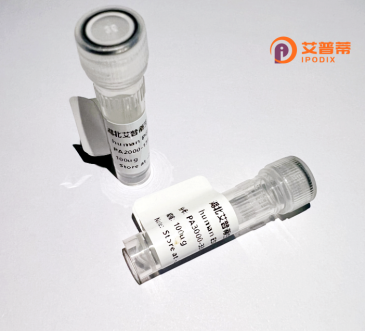
| 纯度 | >90%SDS-PAGE. |
| 种属 | Human |
| 靶点 | PRMT7 |
| Uniprot No | Q9NVM4 |
| 内毒素 | < 0.01EU/μg |
| 表达宿主 | E.coli |
| 表达区间 | 1-692 aa |
| 活性数据 | MKIFCSRANP TTGSVEWLEE DEHYDYHQEI ARSSYADMLH DKDRNVKYYQ GIRAAVSRVK DRGQKALVLD IGTGTGLLSM MAVTAGADFC YAIEVFKPMA DAAVKIVEKN GFSDKIKVIN KHSTEVTVGP EGDMPCRANI LVTELFDTEL IGEGALPSYE HAHRHLVEEN CEAVPHRATV YAQLVESGRM WSWNKLFPIH VQTSLGEQVI VPPVDVESCP GAPSVCDIQL NQVSPADFTV LSDVLPMFSI DFSKQVSSSA ACHSRRFEPL TSGRAQVVLS WWDIEMDPEG KIKCTMAPFW AHSDPEEMQW RDHWMQCVYF LPQEEPVVQG SALYLVAHHD DYCVWYSLQR TSPEKNERVR QMRPVCDCQA HLLWNRPRFG EINDQDRTDR YVQALRTVLK PDSVCLCVSD GSLLSVLAHH LGVEQVFTVE SSAASHKLLR KIFKANHLED KINIIEKRPE LLTNEDLQGR KVSLLLGEPF FTTSLLPWHN LYFWYVRTAV DQHLGPGAMV MPQAASLHAV VVEFRDLWRI RSPCGDCEGF DVHIMDDMIK RALDFRESRE AEPHPLWEYP CRSLSEPWQI LTFDFQQPVP LQPLCAEGTV ELRRPGQSHA AVLWMEYHLT PECTLSTGLL EPADPEGGCC WNPHCKQAVY FFSPAPDPRA LLGGPRTVSY AVEFHPDTGD IIMEFRHADT PD |
| 分子量 | 78.4 kDa |
| 蛋白标签 | His tag N-Terminus |
| 缓冲液 | PBS, pH7.4, containing 0.01% SKL, 1mM DTT, 5% Trehalose and Proclin300. |
| 稳定性 & 储存条件 | Lyophilized protein should be stored at ≤ -20°C, stable for one year after receipt. Reconstituted protein solution can be stored at 2-8°C for 2-7 days. Aliquots of reconstituted samples are stable at ≤ -20°C for 3 months. |
| 复溶 | Always centrifuge tubes before opening.Do not mix by vortex or pipetting. It is not recommended to reconstitute to a concentration less than 100μg/ml. Dissolve the lyophilized protein in distilled water. Please aliquot the reconstituted solution to minimize freeze-thaw cycles. |
以下是关于重组人PRMT7蛋白的3篇参考文献,按照文献名称、作者及摘要内容简要列举:
---
1. **文献名称**: *"Structural basis of substrate methylation and inhibition of protein arginine methyltransferase 7"*
**作者**: Zurita-Lopez CI, et al.
**摘要**: 本研究解析了重组人PRMT7的晶体结构,揭示了其底物结合域的独特构象,证明PRMT7偏好含RXR基序的肽段,并发现小分子抑制剂可阻断其甲基转移酶活性。
2. **文献名称**: *"PRMT7 deficiency causes dysregulation of the epithelial-to-mesenchymal transition pathway"*
**作者**: Ying Z, et al.
**摘要**: 研究利用重组PRMT7蛋白发现其通过甲基化SMAD2/3调控TGF-β信号通路,PRMT7缺失导致EMT异常,与肿瘤转移相关。
3. **文献名称**: *"High-yield expression and purification of recombinant human PRMT7 for functional and structural studies"*
**作者**: Lee J, et al.
**摘要**: 报道一种高效的大肠杆菌表达系统制备重组PRMT7.通过优化条件获得高纯度蛋白,适用于酶活分析和结构生物学研究。
---
以上文献均聚焦于PRMT7的结构、功能表达方法及疾病机制,涵盖重组蛋白制备与应用的核心方向。
Protein arginine methyltransferase 7 (PRMT7) is a member of the PRMT family, which catalyzes the transfer of methyl groups to arginine residues in proteins, playing crucial roles in epigenetic regulation, DNA repair, and cellular signaling. As a type II methyltransferase, PRMT7 primarily generates monomethylarginine (MMA) marks on histones (e.g., H2B, H4) and non-histone substrates, distinguishing it from type I enzymes that produce asymmetric dimethylarginine (ADMA). Structurally, PRMT7 contains two adjacent methyltransferase domains, a unique feature enabling its substrate specificity and catalytic activity, though its precise mechanisms remain under investigation.
PRMT7 is ubiquitously expressed, with high levels in metabolically active tissues like the heart, liver, and skeletal muscle. It regulates diverse biological processes, including embryogenesis, stem cell differentiation, and metabolic homeostasis. Studies link PRMT7 dysregulation to human diseases, such as developmental disorders (e.g., growth retardation syndromes), neurodegenerative conditions, and cancers. Its role in cancer appears context-dependent, acting as both a tumor suppressor (by silencing oncogenes) and an oncogenic driver (via promoting metastasis), highlighting its complex regulatory networks.
Recombinant human PRMT7 protein, often produced in *E. coli* or insect cell systems, is widely used to study methylation kinetics, substrate interactions, and inhibitor screening, aiding therapeutic development. Ongoing research focuses on elucidating its tissue-specific functions and interplay with other epigenetic modifiers.
×